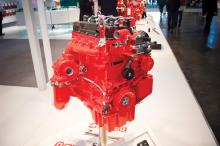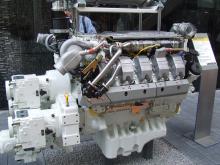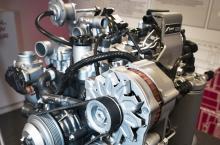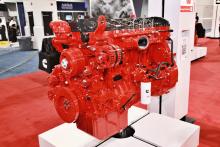Innovative new engine emissions control technology is coming to market - Mike Woof reports. The diesel engine sector has been one of the most active and innovative areas for technological development in the past 10 years. Engine firms have invested enormous sums in developing new, low emissions technologies that reduce the quantities of nitrous oxide and particulates from the tailpipe. All the firms have taken a different approach in this regard, using various combinations of the technologies available such
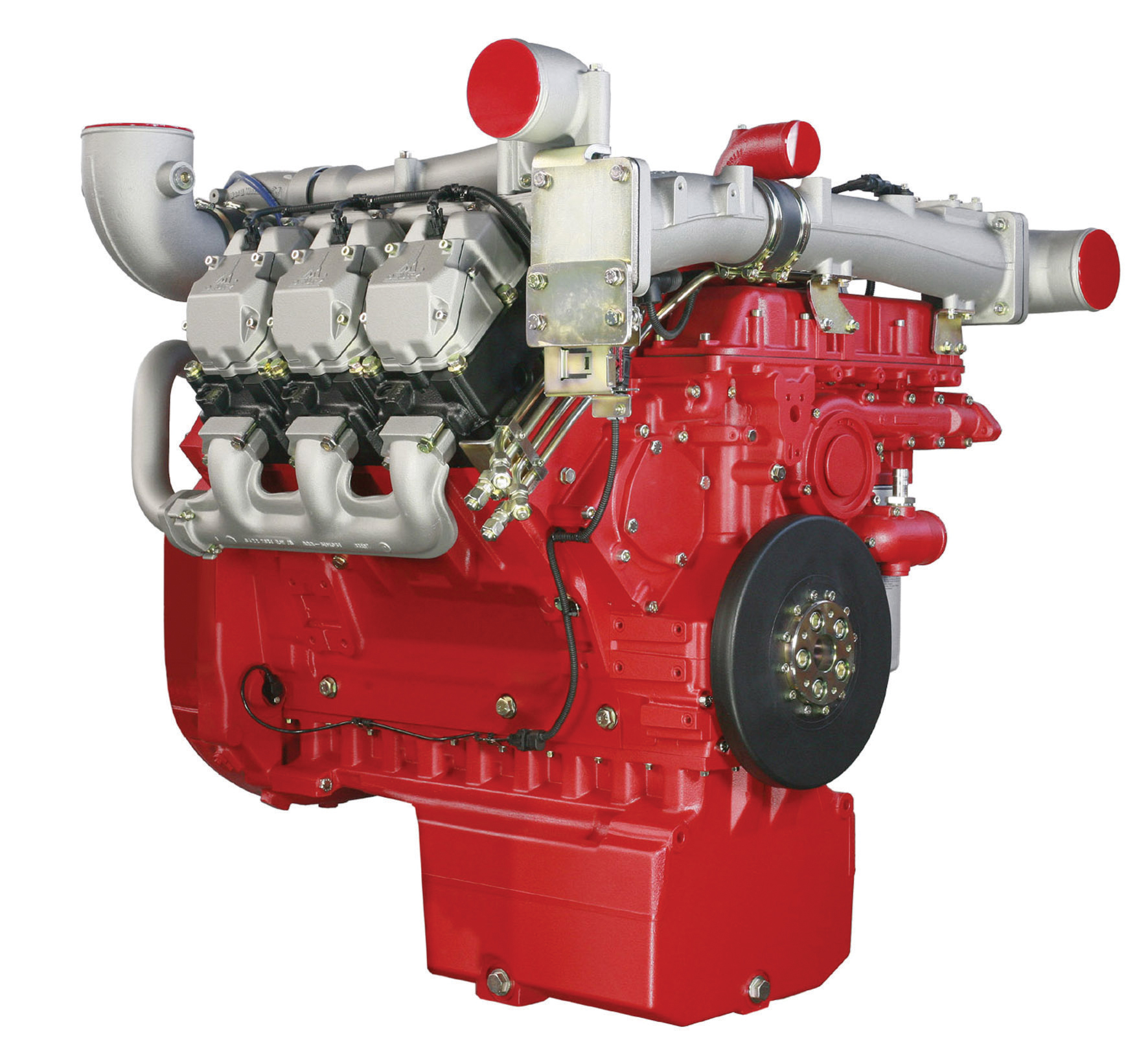
Deutz is using its DVERT emissions solutions package to meet regulations
RSS
These technologies have all required major changes to the machines as the engines run hotter and require more cooling, as well as having to be quieter. The often bulky after-treatment systems all take up more room also, resulting in equipment manufacturers having to carry out careful redesigns of their machines to ensure that visibility for the operator can be maintained, while also allowing service access for these new components.
January 2014 will be a major milestone for this technological development as this is when machines sold into North America, the1116 European Union and Japan will have to begin to comply with the toughest set of emissions legislation yet,
Tier 4 Final/Stage IV. The legislation is introduced in phases with different engine power output categories having to meet these tough targets at different times. But engine firms are already unveiling the low emissions solutions they will be offering for use in Europe, Japan and the US from January 2014.
These latest low emissions engines require clean fuel supplies and can only be used in markets where low sulphur fuel is available however. And this has resulted in manufacturers developing new machines for emerging markets where the low emissions technology is not required and featuring the earlier and well-proven Tier 2/Stage II or Tier 3/Stage III technology.
From196 Cummins now comes a range of engine solutions with power outputs from 37kW right up to 3,130kW, with the massive QSK95. Notable technical development has been made at the lower end of the firm’s line-up and the 2.8litre QSF2.8 joins the range and sits alongside the new 3.8litre QSF3.8, which offers a power range of 63-98kW. The QSF3.8 is a 3.8litre motor, is EU Stage IIIB ready and features high pressure common rail and full electronic control. By using cooled exhaust gas recirculation (EGR) and Selective Catalytic Reduction, Cummins has been able to meet the emissions regulation without the need for a diesel particulate filter (DPF) on its compact engines. This is an important issue as it will help lower maintenance costs.
The new Tier 4 Final/Stage IV emissions certified engine range from201 Deutz offers capacities from 2.9-16litres. The low emissions performance is achieved using the Deutz DVERT technology, a package of technical solutions that is used in modular form with an array of options. Compact design and high torque output are claimed across the range and Deutz says that the engines offer higher power density than previous generation units, allowing these diesels to take the place of larger capacity motors available earlier. This design allows space in an engine compartment for hydraulics as well as the exhaust filtration and after-treatment systems. The range starts with the compact 2.9litre TCD2.9L4 engine, a four-cylinder unit available in both turbocharged and naturally aspirated versions and which offers power outputs from 30-55kW while being designed to fit into tight installations. The TCD3.6L4 and TCD4.1L4 are also four-cylinder units with power outputs from 56-97kW and 80-115kW respectively, while the TCD6.1L6 and TCD7.8L6 are six-cylinder engines available in ratings from 100-180kW and 160-250kW respectively. The TCD12.0V6 has power ratings from 240-390kW and has a V6 configuration, while its larger size means it features emissions systems from the DVERT range including selective catalytic reduction (SCR), as well as cooled external exhaust gas regeneration (EGR) and a particulate filter. The V8 configuration, 16litre engine is due shortly and will offer power ratings up to 520kW, as well as using similar emissions systems to the V6 diesel. All the engines are said to benefit from low fuel consumption, helping to reduce running costs for the owner and offsetting the additional cost of the emissions package.
7125 Hatz Diesel is launching the H series, a 2litre water-cooled engine family that features 3405 Bosch common rail fuel injection with pressures up to 1,800bar. Producing 56kW and 130Nm of torque, the engine uses exhaust gas recirculation (EGR) and a diesel oxidation catalyst (DOC) but does without a diesel particulate filter (DPF). Hatz is also unveiling a concept single-cylinder engine, the 1D81 hydro. As the name suggests this single-cylinder motor is also water-cooled, a major departure for Hatz. The engine is particularly compact and uses an integral radiator, with no external hoses. This means that the engine is barely larger than the company’s standard air-cooled 1D81.
255 JCB’s Ecomax engine – the company’s innovative solution to Stage IIIB/ Tier 4 emissions legislation – requires neither DPF nor after-treatment. The firm claims it is the only leading equipment manufacturer in the world to have met this emissions legislation without a DPF or after-treatment and has used innovative in-cylinder technologies (patent pending) resulting in a cleaner, more efficient combustion process. This is said to have eliminated the need for any external exhaust after-treatment, significantly reducing operating costs. Said to build on the success of the original Dieselmax engine and retaining key features such as high torque at low engine revs, robustness, reliability, and low noise and vibration, the Ecomax is said to be the result of a US$124.1 million investment programme.
In addition to lower emissions, the JCB Ecomax engine is also said to offer customers improved torque throughout the rev range, coupled with noticeably reduced fuel consumption. As it has no after-treatment, it can be recalibrated by JCB dealers to lower injection pressures and turn off the EGR function, without any hardware changes. The Ecomax’s new electronic ECU has been integrated with JCB LiveLink advanced telematics system. As well as location information, routine service notifications and critical machine health alerts, JCB LiveLink is said to offer customers remote access to full Ecomax engine diagnostics and fuel economy data via the internet or through their mobile phones. The JCB Ecomax engine range will be fitted into machines spanning the 54.42-127.24kW range, including JCB backhoe loaders, Loadall telescopic handlers, wheeled loading shovels, the TM range of telescopic boom wheeled loaders, JS excavators, rough terrain forklifts and skid steer loaders.
257 John Deere Power Systems (JDPS) is unveiling its Tier 4 Final/Stage IV diesel engine line-up with displacements of 2.9, 4.5, 6.8, 9 and 13.5litres. John Deere’s 3089 PowerTech line up uses the firm’s building-block approach to meet the regulations, and to achieve compliance it has developed the Integrated Emissions Control system, a solution that is said to optimises engine performance, operating efficiency and reliability while offering flexibility to customers.
The2278 Kohler Engines/2277 Lombardini group is updating its range of air-cooled single cylinder diesel engines, unveiling the new 8kW KD15-440 engine which will strengthen and improve the current 15LD series. The KD15-440 is an air-cooled single cylinder diesel engine with a displacement of 441cc and an air filter that can offer an operating life five times greater than the current version due to its new high-efficiency separator with pre-filter and an accumulated-dust drain valve. There is also a new fuel filter featuring additional pre-filter protection. Further up the power chain, Lombardini has a new line of Kohler Direct Injection (KDI) diesel engines, all of which have been prepared to meet the demands of the latest emissions regulations. This new and updated KDI series achieves clean diesel fuel combustion by using a high-pressure (2000bar) common rail system, combined with an electronically triggered EGR valve. This enables emissions levels to comply with the new regulations while providing exceptional performance, without the use of after-treatment systems. There are three direct injection families, each with a different displacement rated at 1.9litres, 2.5litres, and 3.4litres, and each one is available in two different configurations: Mechanical injection to comply with Tier 3/Stage IIIA emissions requirements; or common rail injection to comply with Tier 4/Stage IIIB emissions requirements.
299 Perkins is unveiling a complete line-up of Stage IV/Tier 4 Final engine solutions, ahead of the new legislation next year. The four-cylinder 854F-E34TA will demonstrate much of the technology on offer, as it uses Selective Catalytic Reduction (SCR) with an exhaust additive, plus a Diesel Oxidation Catalyst (DOC). Both Perkins’ 3.4 and 4.4litre engine lines make do without a Diesel Particulate Filter (DPF), though the larger 7litre will use a DPF as well.
Perkins has boosted performance of the 854F-E34TA engine to 90kW, despite retaining the 8% fuel consumption improvement that was achieved at Stage IIIB. Heat rejection is also similar, so manufacturers should not need to install larger cooling packs to cope with the move to Stage IV.
Also on show will be a 1200 Series 1206F-E70TA, with an output of 151kW. This engine packages the DOC/DPF and SCR systems in a single integrated module, which can be remotely mounted in the machine, again making it easier for machine OEMs to make the change to Stage IV standards in the coming years. Perkins says that its DPF should remain service-free for up to 8,000 hours on a 60% duty cycle. It will be possible for customers to have the DPF cleaned or replaced when the time comes and the company can check how far into the process the DPF is for used equipment sales. Perkins also claims to have a process in place for its engines to be de-Tiered, for machine resale in less regulated territories.
759 Scania has both Euro 6 engines for its on-highway truck range and Stage IV/Tier 4 Final powerplants for off-highway use. The company is using both exhaust gas recirculation (EGR) and selective catalytic reduction (SCR) to meet the coming regulations, as with its current Stage IIIB solution. This means the fitting of a diesel oxidation catalyst (DOC) but no requirement for a DPF. Scania engines are currently in use in 1222 Terex and 695 Doosan articulated haulers, along with a number of Terex crushing machines.
783 Volvo Penta says it is ready for a follow-up of the new Tier 4 Final engine range and for displaying engine features such as the start/stop function, which is designed to cut fuel consumption. To meet the new, stringent emissions requirements of Tier 4 Final, and using the SCR technology, Volvo Penta says its new Tier 4 Final engine range will meet customers’ primary objectives: no re-generation, limited installation challenges, continuous optimised fuel consumption and low operating costs, with as few and as simple changes as possible. The company says the light EGR system added to the engines has provided further emissions reduction. This will also help keep the SCR catalyst operating at an optimal temperature. By avoiding a costly Diesel Oxidation Catalyst (DOC), installation is greatly simplified.
The Volvo Penta Tier 4 Final range for off-road applications consists of five basic engines, which will be ready for delivery in 2014. Volvo Penta will also introduce the new, automatic start/stop function for industrial equipment, which turns off an idling engine after a pre-set time span, and when the driver activates any machine control the engine starts immediately and the work can continue. For the mining industry, Volvo Penta has a new range of engines approved for underground mining applications: nine Tier 2 engines and nine Tier 4 Interim engines.
Lastly,7139 Yanmar is unveiling a full range of California 4198 Air Resources Board (CARB) certified engines at bauma. The company claims to be the first engine manufacturer to achieve the CARB accreditation across its complete line-up in the 19-56kW range, and the engines all meet the US Tier 4 Final standard as well. The firm is also announcing an electronic diagnostic service system called Smart Assist-Direct. The system allows rapid updates of engine software and can automatically retrieve technical service information from the equipment.RSS
Innovative new engine emissions control technology is coming to market - Mike Woof reports
The diesel engine sector has been one of the most active and innovative areas for technological development in the past 10 years. Engine firms have invested enormous sums in developing new, low emissions technologies that reduce the quantities of nitrous oxide and particulates from the tailpipe. All the firms have taken a different approach in this regard, using various combinations of the technologies available such as diesel particulate filters (DPF), selective catalytic reduction (SCR), exhaust gas regeneration (EGR) and high-pressure, common rail fuel systems.These technologies have all required major changes to the machines as the engines run hotter and require more cooling, as well as having to be quieter. The often bulky after-treatment systems all take up more room also, resulting in equipment manufacturers having to carry out careful redesigns of their machines to ensure that visibility for the operator can be maintained, while also allowing service access for these new components.
January 2014 will be a major milestone for this technological development as this is when machines sold into North America, the
Tier 4 Final/Stage IV. The legislation is introduced in phases with different engine power output categories having to meet these tough targets at different times. But engine firms are already unveiling the low emissions solutions they will be offering for use in Europe, Japan and the US from January 2014.
These latest low emissions engines require clean fuel supplies and can only be used in markets where low sulphur fuel is available however. And this has resulted in manufacturers developing new machines for emerging markets where the low emissions technology is not required and featuring the earlier and well-proven Tier 2/Stage II or Tier 3/Stage III technology.
From
The new Tier 4 Final/Stage IV emissions certified engine range from
In addition to lower emissions, the JCB Ecomax engine is also said to offer customers improved torque throughout the rev range, coupled with noticeably reduced fuel consumption. As it has no after-treatment, it can be recalibrated by JCB dealers to lower injection pressures and turn off the EGR function, without any hardware changes. The Ecomax’s new electronic ECU has been integrated with JCB LiveLink advanced telematics system. As well as location information, routine service notifications and critical machine health alerts, JCB LiveLink is said to offer customers remote access to full Ecomax engine diagnostics and fuel economy data via the internet or through their mobile phones. The JCB Ecomax engine range will be fitted into machines spanning the 54.42-127.24kW range, including JCB backhoe loaders, Loadall telescopic handlers, wheeled loading shovels, the TM range of telescopic boom wheeled loaders, JS excavators, rough terrain forklifts and skid steer loaders.
The
Perkins has boosted performance of the 854F-E34TA engine to 90kW, despite retaining the 8% fuel consumption improvement that was achieved at Stage IIIB. Heat rejection is also similar, so manufacturers should not need to install larger cooling packs to cope with the move to Stage IV.
Also on show will be a 1200 Series 1206F-E70TA, with an output of 151kW. This engine packages the DOC/DPF and SCR systems in a single integrated module, which can be remotely mounted in the machine, again making it easier for machine OEMs to make the change to Stage IV standards in the coming years. Perkins says that its DPF should remain service-free for up to 8,000 hours on a 60% duty cycle. It will be possible for customers to have the DPF cleaned or replaced when the time comes and the company can check how far into the process the DPF is for used equipment sales. Perkins also claims to have a process in place for its engines to be de-Tiered, for machine resale in less regulated territories.
The Volvo Penta Tier 4 Final range for off-road applications consists of five basic engines, which will be ready for delivery in 2014. Volvo Penta will also introduce the new, automatic start/stop function for industrial equipment, which turns off an idling engine after a pre-set time span, and when the driver activates any machine control the engine starts immediately and the work can continue. For the mining industry, Volvo Penta has a new range of engines approved for underground mining applications: nine Tier 2 engines and nine Tier 4 Interim engines.
Lastly,


